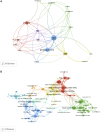Trends in volume-regulated anion channel (VRAC) research: visualization and bibliometric analysis from 2014 to 2022
- PMID: 37538172
- PMCID: PMC10394876
- DOI: 10.3389/fphar.2023.1234885
Trends in volume-regulated anion channel (VRAC) research: visualization and bibliometric analysis from 2014 to 2022
Abstract
Objective: In this study, we utilized bibliometric methods to assess the worldwide scientific output and identify hotspots related to the research on the volume-regulated anion channel (VRAC) from 2014 to 2022. Methods: From Web of Science, we obtained studies related to VRAC published from 2014 to 2022. To analyzed the data, we utilized VOSviewer, a tool for visualizing network, to create networks based on the collaboration between countries, institutions, and authors. Additionally, we performed an analysis of journal co-citation, document citation, and co-occurrence of keywords. Furthermore, we employed CiteSpace (6.1. R6 Advanced) to analyzed keywords and co-cited references with the strongest burst. Results: The final analysis included a total of 278 related articles and reviews, covering the period from 2014 to 2022. The United States emerged as the leading country contributing to this field, while the University of Copenhagen stood out as the most prominent institution. The author with most publications and most citations was Thomas J. Jentsch. Among the cited references, the article by Voss et al. published in Science (2014) gained significant attention for its identification of LRRC8 heteromers as a crucial component of the volume-regulated anion channel VRAC. Pflügers Archiv European Journal of Physiology and Journal of Physiology-London were the leading journals in terms of the quantity of associated articles and citations. Through the analysis of keyword co-occurrence, it was discovered that VRAC is involved in various physiological processes including cell growth, migration, apoptosis, swelling, and myogenesis, as well as anion and organic osmolyte transport including chloride, taurine, glutamate and ATP. VRAC is also associated with related ion channels such as TMEM16A, TMEM16F, pannexin, and CFTR, and associated with various diseases including epilepsy, leukodystrophy, atherosclerosis, hypertension, cerebral edema, stroke, and different types of cancer including gastric cancer, glioblastoma and hepatocellular carcinoma. Furthermore, VRAC is involved in anti-tumor drug resistance by regulating the uptake of platinum-based drugs and temozolomide. Additionally, VRAC has been studied in the context of pharmacology involving DCPIB and flavonoids. Conclusion: The aim of this bibliometric analysis is to provide an overall perspective for research on VRAC. VRAC has become a topic of increasing interest, and our analysis shows that it continues to be a prominent area. This study offers insights into the investigation of VRAC channel and may guide researchers in identifying new directions for future research.
Keywords: LRRC8; SWELL1; bibliometric analysis; research direction; volume-regulated anion channel (VRAC).
Copyright © 2023 Liu, Li, Wang, Stauber and Zhao.
Conflict of interest statement
The authors declare that the research was conducted in the absence of any commercial or financial relationships that could be construed as a potential conflict of interest.
Figures









Similar articles
-
Research Trends in the Application of Artificial Intelligence in Oncology: A Bibliometric and Network Visualization Study.Front Biosci (Landmark Ed). 2022 Aug 31;27(9):254. doi: 10.31083/j.fbl2709254. Front Biosci (Landmark Ed). 2022. PMID: 36224012
-
Bibliometric study of immunotherapy for hepatocellular carcinoma.Front Immunol. 2023 Aug 4;14:1210802. doi: 10.3389/fimmu.2023.1210802. eCollection 2023. Front Immunol. 2023. PMID: 37600802 Free PMC article. Review.
-
Scientific mapping of hotspots and trends of post and core research based on the Web of Science: A bibliometric analysis.Heliyon. 2023 Dec 19;10(1):e23786. doi: 10.1016/j.heliyon.2023.e23786. eCollection 2024 Jan 15. Heliyon. 2023. PMID: 38226214 Free PMC article.
-
A bibliometric and visualization analysis of research trends and hotspots on targeted therapy for breast cancer from 2003 to 2022.Front Oncol. 2024 Jun 4;14:1366900. doi: 10.3389/fonc.2024.1366900. eCollection 2024. Front Oncol. 2024. PMID: 38894873 Free PMC article.
-
Trends of mitochondrial changes in AD: a bibliometric study.Front Aging Neurosci. 2023 May 16;15:1136400. doi: 10.3389/fnagi.2023.1136400. eCollection 2023. Front Aging Neurosci. 2023. PMID: 37261264 Free PMC article.
Cited by
-
Bubble-Wall Plot as a Dynamic Analytical Processing Visualization Tool for Developing Visual Warning Systems: a Case Study.PLoS One. 2025 Jul 1;20(7):e0321077. doi: 10.1371/journal.pone.0321077. eCollection 2025. PLoS One. 2025. PMID: 40591578 Free PMC article.
-
Recent insights on the impact of SWELL1 on metabolic syndromes.Front Pharmacol. 2025 Mar 21;16:1552176. doi: 10.3389/fphar.2025.1552176. eCollection 2025. Front Pharmacol. 2025. PMID: 40191429 Free PMC article. Review.
-
Physiology of the volume-sensitive/regulatory anion channel VSOR/VRAC. Part 1: from its discovery and phenotype characterization to the molecular entity identification.J Physiol Sci. 2024 Jan 18;74(1):3. doi: 10.1186/s12576-023-00897-x. J Physiol Sci. 2024. PMID: 38238667 Free PMC article. Review.
-
Chloride channels and mast cell function: pioneering new frontiers in IBD therapy.Mol Cell Biochem. 2025 Jul;480(7):3951-3969. doi: 10.1007/s11010-025-05243-w. Epub 2025 Mar 4. Mol Cell Biochem. 2025. PMID: 40038149 Review.
References
LinkOut - more resources
Full Text Sources

